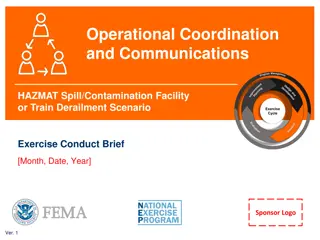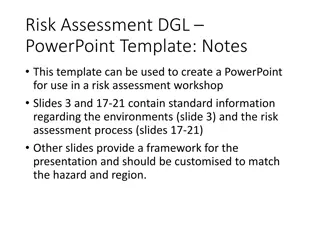Comprehensive Operational Risk Scenario Analysis Template
This template aids risk and operations managers in systematically identifying, assessing, and mitigating operational risks that could disrupt daily business operations. It allows for detailed risk analysis, scenario development, and mitigation strategy planning to ensure effective risk management. Continuous monitoring and review are emphasized to adapt strategies as the business environment evolves.
Download Presentation

Please find below an Image/Link to download the presentation.
The content on the website is provided AS IS for your information and personal use only. It may not be sold, licensed, or shared on other websites without obtaining consent from the author.If you encounter any issues during the download, it is possible that the publisher has removed the file from their server.
You are allowed to download the files provided on this website for personal or commercial use, subject to the condition that they are used lawfully. All files are the property of their respective owners.
The content on the website is provided AS IS for your information and personal use only. It may not be sold, licensed, or shared on other websites without obtaining consent from the author.
E N D
Presentation Transcript
Example Operational Risk Scenario Analysis Template When to Use This Template: This operational risk scenario analysis template with or without sample data is best for risk managers and operations managers who need to identify and assess risks that could disrupt daily operations. It s an essential tool during risk assessment meetings or operational planning sessions. Notable Template Features: This template is designed to help you systematically outline and analyze operational risks. It includes sections for assessing the likelihood and potential impact of each risk, as well as for planning mitigation strategies. The template s structured format helps you create actionable contingency plans, making it an indispensable tool for comprehensive operational risk management.
Text Risk Identification Identify potential operational risks that could impact the business. These include risks related to processes, people, systems, external events, etc. Risk Assessment Assess the likelihood and potential impact of each scenario by evaluating the severity and probability of risks occurring. Implementation Put risk mitigation strategies into action. This stage involves integrating these strategies into regular business operations and processes. Scenario Development Develop scenarios for each identified risk. These scenarios describe how each risk could manifest and impact the organization. Mitigation Strategy Planning Plan strategies to mitigate identified risks. These strategies include developing procedures to prevent risks and managing risks if they occur. Monitoring and Review Continuously monitor the effectiveness of risk mitigation strategies and review them regularly. By doing this, you can ensure that the strategies remain effective and current as the business and its external environment evolve.
Positive Charge Risk Identification Identify potential risks such as power outages affecting charging stations, technology failures, supply chain disruptions for equipment, or changes in regulatory policies impacting EV infrastructure. Risk Assessment Assess the likelihood of a power grid failure and its impact on station operation hours. Evaluate the probability of software issues and their effect on customer satisfaction and safety. Implementation Implement the risk mitigation strategies by installing backup generators at key charging stations, regularly updating and testing software systems, and monitoring policy developments. Scenario Development Develop scenarios like a major power grid failure leading to charging station downtime, a critical software malfunction in the charging network, or delays in equipment delivery due to supplier issues. Mitigation Strategy Planning Plan strategies such as establishing backup power solutions, implementing robust IT system checks, maintaining a diversified supplier network, and staying updated with policy changes. Monitoring and Review To ensure you re effectively managing ongoing risk and adapting strategies as needed, continuously monitor the performance of backup power systems, conduct regular software audits, assess supplier reliability, and stay abreast of policy changes.
DISCLAIMER Any articles, templates, or information provided by Smartsheet on the website are for reference only. While we strive to keep the information up to date and correct, we make no representations or warranties of any kind, express or implied, about the completeness, accuracy, reliability, suitability, or availability with respect to the website or the information, articles, templates, or related graphics contained on the website. Any reliance you place on such information is therefore strictly at your own risk.























